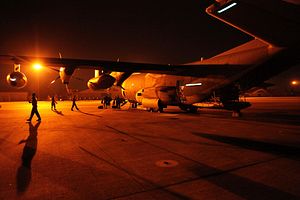How vulnerable are U.S. bases in the Pacific? A new report by Commander Thomas Shugart and Commander Javier Gonzalez at the Center for a New American Security (CNAS) suggests that the constellation of U.S. bases in the region has become deeply vulnerable to attack by Chinese ballistic missiles.
While the threat of anti-ship ballistic missiles has captured many of the headlines regarding the changing balance of power in the Pacific, the authors of the report argue that land-based installations are just as tenuous, if not more so. China’s PLA Rocket Force (PLARF) enjoys a degree of independence that has no useful counterpart in the American system. The report suggests that China currently deploys upwards of 1,600 conventionally armed ballistic missiles of various ranges. These missiles can carry a variety of payloads, including submunitions designed to severely damage above-ground military installations. Ground launched cruise missiles, flying on pre-determined courses at low altitude, can also inflict considerable damage with little warning.
Built around a series of carefully delineated assumptions, Shugart and Gonzalez simulated a preemptive Chinese attack against U.S. bases in Japan and elsewhere in Asia. In the simulation, Chinese missiles destroyed nearly every headquarters and logistical facility, along with virtually every U.S. ship in port, and some two hundred U.S. combat aircraft. In short, depending on the degree of surprise, China can cripple U.S. military capabilities in the Asia-Pacific while using only a fraction of its conventional missile arsenal.
China’s missile strategy has historic and contemporary analogues. Late Soviet doctrine envisioned precision ballistic missile strikes against NATO bases in the opening hours of a general confrontation on the Central Front. North Korean military strategy relies on attacking a wide range of civilian and military installations in South Korea and elsewhere with conventional, and possibly nuclear and biochemical, payloads. The U.S. pursuit of ballistic missile defense has, in significant part, been driven by the increasing military threat that conventional missiles pose.
What can the United States do? Much depends on how effectively the U.S. ferrets out notice of Chinese attack. While any war between the United States and China is highly likely to begin with an attack by the latter, the damage caused by such an attack remains subject to many variables. The U.S. can disperse aircraft, command and control assets, and logistical support requirements in ways that would complicate Chinese targeting, if the former receives sufficient warning of the latter’s attack. The analysis also opens up the potential for inter-service competition. The U.S. Air Force and the U.S. Army depend on bases in the Western Pacific to a greater extent than the U.S. Navy, although the latter also requires considerable support for assets afloat. As Shugart and Gonzalez point out, aircraft carriers can rely on speed and mobility to avoid precision first-strikes in a way that fixed bases cannot.
Perhaps the most important factor in avoiding war between China and the United States involves reducing the incentives for preemption. If victory determines or necessitates a first strike, then crises become deeply unstable. Shugart and Gonzalez suggest that we are very close to living in this reality.

































